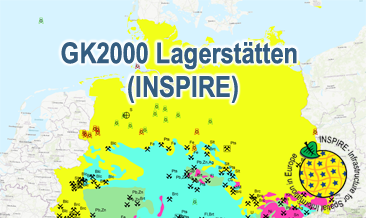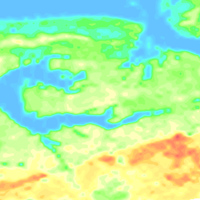Keyword
uranium
6 record(s)
Provided by
Type of resources
Available actions
Topics
Keywords
Contact for the resource
Service types
-

The WMS GK2000 Lagerstätten (INSPIRE) shows deposits and mines of energy resources, metal resources, industrial minerals and salt on a greatly simplified geology within Germany on a scale of 1:2,000,000. According to the Data Specification on Mineral Resources (D2.8.III.21) and Geology (D2.8.II.4_v3.0) the map provides INSPIRE-compliant data. The WMS GK2000 Lagerstätten (INSPIRE) contains the following layers: MR.Mine displays mines. MR.MineralOccurence.Commodity.Polygon.EnergyResources displays energy resources as polygons. GE.GeologicUnits provides the greatly simplified geology of Germany. For different geochronologic minimum and maximum ages, e.g. Precambrian - Cenozoic, the portrayal is defined by the colour of the geochronologic minimum age (olderNamedAge). The user obtains detailed information on the deposits, mines and geology via the getFeatureInfo request. Notes regarding the portrayal: The gas and oil provinces as well as the corresponding mines are coloured in green and red according to common international practice. The black coal fields are displayed in their original colour grey. The colouring of the brown coal fields correspond to the KOR250 respectively KOR250 (INSPIRE) colouring. All mine symbols and commodity abbrevations are BGR symbols and abbrevations.
-

The GK2000 Lagerstätten (INSPIRE) shows deposits and mines of energy resources, metal resources, industrial minerals and salt on a greatly simplified geology within Germany on a scale of 1:2,000,000. According to the Data Specifications on Mineral Resources (D2.8.III.21) and Geology (D2.8.II.4_v3.0) the content of the map is stored in three INSPIRE-compliant GML files: GK2000_Lagerstaetten_Mine.gml contains mines as points. GK2000_ Lagerstaetten _EarthResource_polygon_Energy_resources.gml contains energy resources as polygons. GK2000_ Lagerstaetten _GeologicUnit.gml contains the greatly simplified geology of Germany. The GML files together with a Readme.txt file are provided in ZIP format (GK2000_ Lagerstaetten -INSPIRE.zip). The Readme.text file (German/English) contains detailed information on the GML files content. Data transformation was proceeded by using the INSPIRE Solution Pack for FME according to the INSPIRE requirements.
-

The BGR helicopter (Sikorsky S-76B) is used for airborne geophysical surveying of the Earth’s subsurface. The standard equipment comprises the methods electromagnetics, magnetics and radiometrics. The passive helicopter-borne radiometric (HRD) measuring system is a gamma-ray spectrometer, which is installed into the helicopter. The detector of the spectrometer consists of five Sodium-iodide crystals (volume: 4 l per NaI crystal). The spectral range of gamma radiation recorded ranges from 0 to 3 MeV. The results are displayed as total count rate and the (equivalent) concentrations of Thorium, Uranium and Sodium as well as the exposure rate at ground level.
-

BGR conducted an airborne survey in the region of the Hadelner Marsch in cooperation with the GGA Institute (now LIAG) as well as with the water suppliers of Land Hadeln and Wingst. The survey area Hadelner Marsch (2004) is bounded by the river Elbe to the north and by the settlements Bederkesa and Lamstedt to the south. The size of the area is about 700 km². The area was surveyed with 20 flights totalling to 2970 line-km (75,822 survey points). The nominal separation of the 117 ESE-WNW lines and 13 NNE-SSW tie lines was 250 m and 2000 m, respectively. The maps display the total count, the (equivalent) content of potassium, uranium and thorium as well as the exposure rate at ground.
-
The BGR helicopter (Sikorsky S-76B) is used for airborne geophysical surveying of the Earth’s subsurface. The standard equipment comprises the methods electromagnetics, magnetics and radiometrics. The passive radiometric (HRD) system is installed into the helicopter and consists of a gamma-ray spectrometer with five Sodiumiodid detectors to measure the gamma radiation. Besides the total counts, the (equivalent) concentrations of potassium, thorium and uranium at ground level as well as the exposure rate are derived.
-
BGR conducted an airborne survey in the region of the Hadelner Marsch in cooperation with the GGA Institute (now LIAG) as well as with the water suppliers of Land Hadeln and Wingst. The survey area Hadelner Marsch (2004) is bounded by the river Elbe to the north and by the settlements Bederkesa and Lamstedt to the south. The size of the area is about 700 km². The area was surveyed with 20 flights totalling to 2970 line-km (75,822 survey points). The nominal separation of the 117 ESE-WNW lines and 13 NNE-SSW tie lines was 250 m and 2000 m, respectively. The ASCII datafile contains the raw data as well as the processed HRD data.
 www.geodatenkatalog.de (S1L)
www.geodatenkatalog.de (S1L)